Low back pain?
You’re not alone, low back pain affects over 80% of the population at some point in their lives. It’s the top reason why people seek care from a chiropractor and the third most common reason why someone sees any other physician. This multi-part series aims to educate you about the most common causes of low back pain and the ways in which you can prevent them.
–Tight hip flexors:
Probably the most common and most fixable condition I come across. The iliopsoas (primary hip flexor) muscle(s) originate in the low back and attach to the top of your femur. If you sit more than you stand everyday, you probably have tight hip flexors.
Sitting puts the hip flexors in a shortened position because your leg is flexed (as seen below). Since our bodies are so good at adaptation, this becomes the “normal” position, due to muscle memory. If you sleep on your side in a fetal position (knee flexed, hip flexed), this further enforces this shortened position as “normal” to your body.
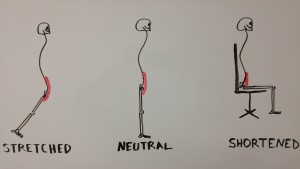
Now, every time you stand up, your hip flexors are being stretched, simply because they are used to being in a flexed/shortened position from sitting and sleeping. This manifests as pain in your low back because the muscles attach to your lumbar spine (seen below).
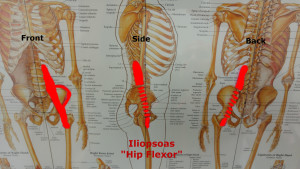
Symptoms of tight hip flexors:
- The most common symptom I see with someone who has tight hip flexors is pain and stiffness transitioning from a seated to standing position. It takes a few moments to get upright, then the discomfort subsides after a few steps. You’ve seen it, the hands on the thighs, pushed up to a hunched position and slowly straightened out.
- You may also notice pain in the front of your hip/upper thigh at the bottom of a squat. While seated/sleeping, your hip flexor is in a shortened position, but it is also relaxed, not contracted. Under the load of a squat, you are now contracting AND shortening the hip flexor, again something your body is not used to in combination, causing pain/burning deep in the hip. This usually subsides after sufficient warm up but is an indicator of hip flexor dysfunction none-the-less.
How to prevent:
- The easiest way to prevent tight hip flexors is to get up and move! If sitting too long causes tight hip flexors, standing/walking more will prevent/combat the imbalance from taking hold. If you are stuck at a desk for 8 hours a day, try getting a standing desk. If that’s not possible, take frequent breaks to get up and walk around.
- Stretching the hips flexors 5+ times per day will help keep them in a neutral position. Below are my favorites stretches. As with all hip flexor stretches, you want to bring the knee behind the pelvis, while keeping your torso as upright as possible.
Figure 1 is an easy hip flexor stretch that can be performed using your bed or couch as a means to slide your leg behind your torso.
Figure 2 is similar to a quad stretch but includes kicking backwards to bring your knee behind your pelvis.
Figure 3 is performed on the floor in a deep lung position with your torso as upright as possible.
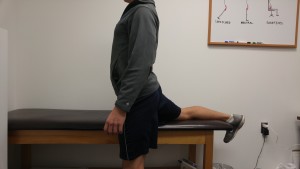
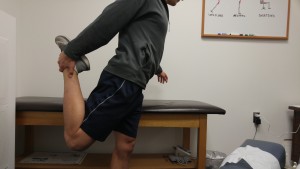
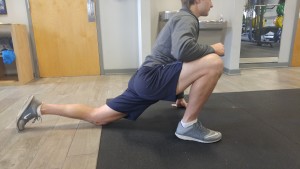
These stretches will help keep your hip flexors at a neutral position as “normal” instead of a shortened position. These should be held for about a minute each leg, multiple times throughout the day to get the desired effects.
**If these stretches seem to increase your back pain, stop doing them, you may have another issue going on, which will be covered next time!**